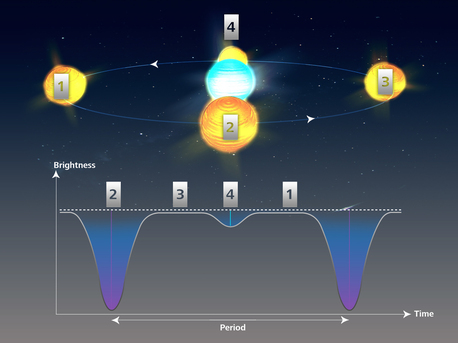Binary Star Systems
What happens when stars play hide-and-seek?
 © DLR |
An eclipsing binary is a binary star system that can be recognized by a periodic change in brightness. The change in brightness is due to the fact that the two starts in the system alternately cover each other on a regular basis, resulting in a brightness curve with brightness minima of varying strengths.
The brightness curve as an indicator of the characteristics of stars
If the smaller star then passes behind the larger one, its light is completely or partially screened: the brightness of the binary star system decreases for a second time – an additional minimum, the secondary minimum, is created in the brightness curve. Whether the primary minimum or the secondary minimum is the lower depends on the difference in brightness between the two stars. If the surface brightness of the smaller star is lower, the primary minimum is lower. The secondary minimum is lower when the larger star is the 'darker' of the two; this is, for example, the case with cool red giants.
From the shape of the brightness curve, we can determine important parameters – the relationship between the radii of the two stars, the period of their orbit and, if the speed at which the stars are moving is known, even the mass of the stars. Probably the most well known eclipsing binary is the star Algol in the constellation Perseus – it regularly changes its brightness with a period of less than three days. The Englishman John Goodricke studied Algol as early as 1783 and concluded that another body was accompanying the visible star.
German Aerospace Center
Binary Star Systems
What happens when stars play hide-and-seek?
 © DLR |
An eclipsing binary is a binary star system that can be recognized by a periodic change in brightness. The change in brightness is due to the fact that the two starts in the system alternately cover each other on a regular basis, resulting in a brightness curve with brightness minima of varying strengths.
The brightness curve as an indicator of the characteristics of stars
If the smaller star then passes behind the larger one, its light is completely or partially screened: the brightness of the binary star system decreases for a second time – an additional minimum, the secondary minimum, is created in the brightness curve. Whether the primary minimum or the secondary minimum is the lower depends on the difference in brightness between the two stars. If the surface brightness of the smaller star is lower, the primary minimum is lower. The secondary minimum is lower when the larger star is the 'darker' of the two; this is, for example, the case with cool red giants.
From the shape of the brightness curve, we can determine important parameters – the relationship between the radii of the two stars, the period of their orbit and, if the speed at which the stars are moving is known, even the mass of the stars. Probably the most well known eclipsing binary is the star Algol in the constellation Perseus – it regularly changes its brightness with a period of less than three days. The Englishman John Goodricke studied Algol as early as 1783 and concluded that another body was accompanying the visible star.
German Aerospace Center








